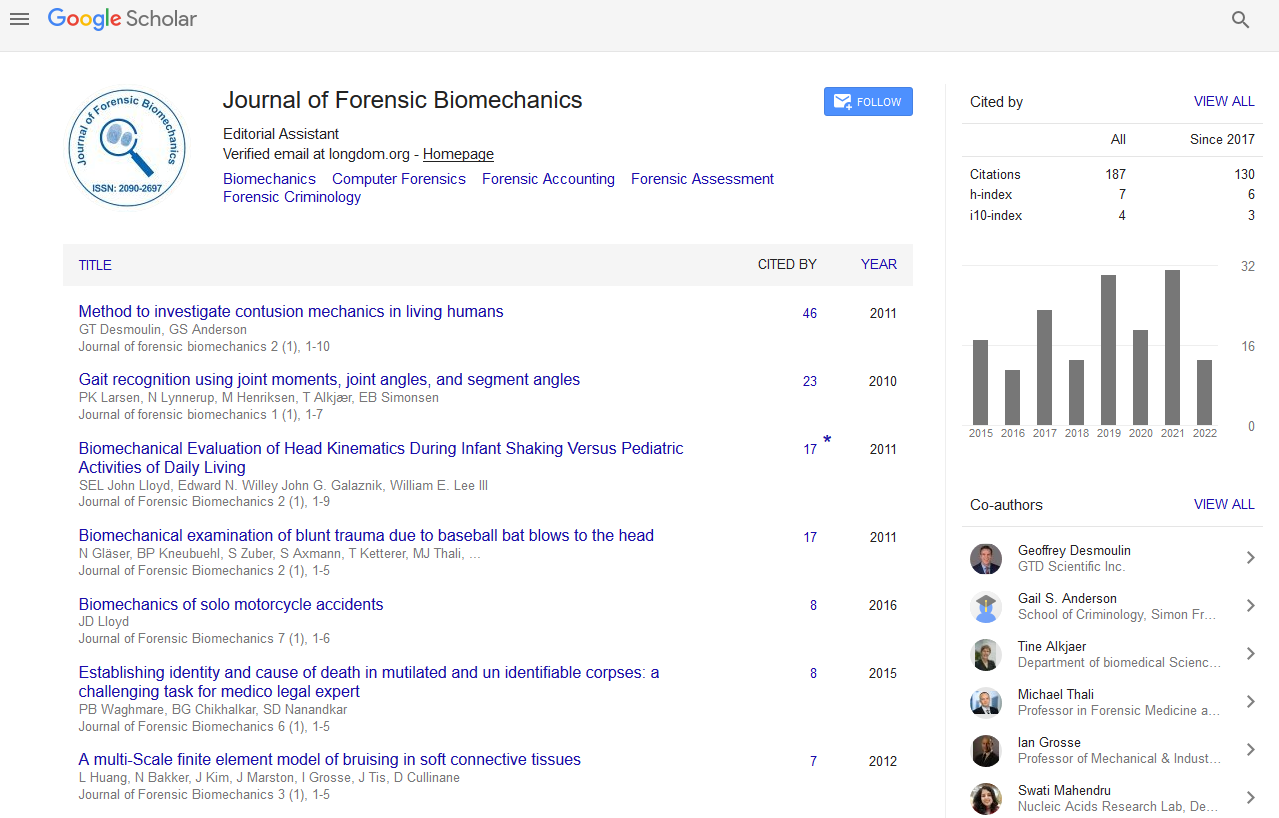Indexed In
- Genamics JournalSeek
- SafetyLit
- Ulrich's Periodicals Directory
- RefSeek
- Hamdard University
- EBSCO A-Z
- Geneva Foundation for Medical Education and Research
- Euro Pub
- Google Scholar
Useful Links
Share This Page
Journal Flyer
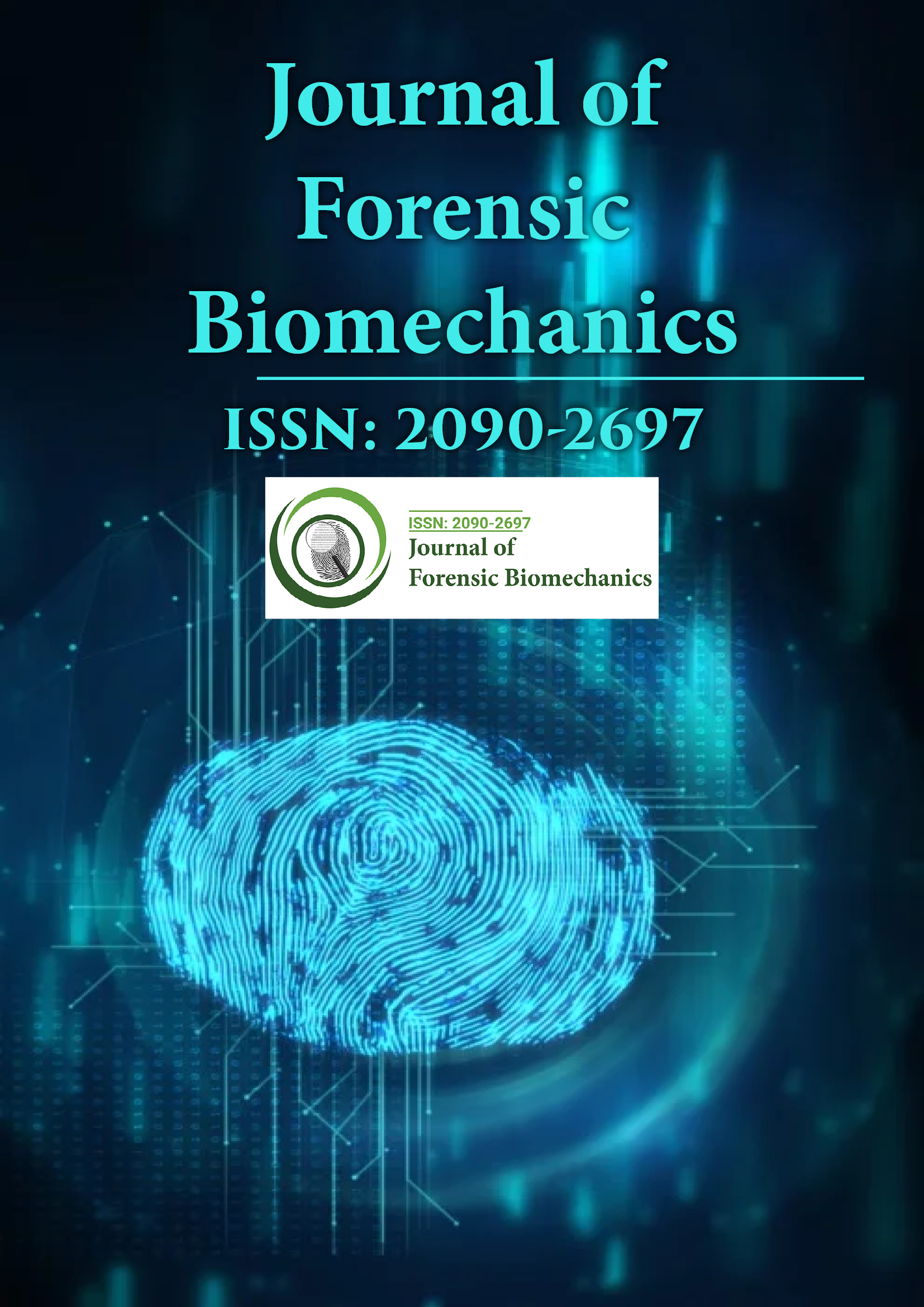
Open Access Journals
- Agri and Aquaculture
- Biochemistry
- Bioinformatics & Systems Biology
- Business & Management
- Chemistry
- Clinical Sciences
- Engineering
- Food & Nutrition
- General Science
- Genetics & Molecular Biology
- Immunology & Microbiology
- Medical Sciences
- Neuroscience & Psychology
- Nursing & Health Care
- Pharmaceutical Sciences
Research Article - (2022) Volume 13, Issue 2
Descriptive Analysis of Ligature Composition in Correlation with Patho-Anatomic Findings in Neck Region Due to Hanging Fatalities
Shibanand Nepal Karmakar*, Nilesh Keshav Tumram and Pradeep Gangadhar DixitDepartment of Forensic Medicine, Government Medical College, Chandrapur, Maharastra, India
Department of Forensic Medicine, Government Medical College, Kolhapur, Maharastra, India
Received: 08-Feb-2022, Manuscript No. JFB-22-15597; Editor assigned: 10-Feb-2022, Pre QC No. JFB-22-15597; Reviewed: 24-Feb-2022, QC No. JFB-22-15597; Revised: 01-Mar-2022, Manuscript No. JFB-22-15597; Published: 08-Mar-2022
Abstract
Background: Hanging is the commonest form of violent asphyxial death cases coming for medico legal autopsy. Ligature material is one of the most important factors determining the causation of external and internal injuries to neck in hanging. The material make and the surface characteristic of the ligature material are determinant characteristics of a ligature material. Study of both external and internal injuries over neck, are important in cases of hanging.
Methods: A total of 95 cases of suicidal hanging cases were included in study. Cases without insitu ligature material around neck, cases with inadequate history, doubtful findings and bodies which were brought in decomposed state were excluded. The cases where ligature material was present in situ around neck were included in the study. Also where the history and crime scene was known by the investigating agency and body was found in hanging condition without disturbances of scene of crime were included in study.
Results: Nylon rope was the most commonly used ligature material (52.6%). Hard and rough group of ligature material was the commonest group of ligature material and was also the commonest group for the causation of various external injuries and internal injuries.
Conclusion: It was concluded that there is increased prevalence of external and internal injuries in hard make ligature materials and rough surface ligature materials. Detailed analysis of ligature materials and their types can help in correlating the various anatomical and pathological findings associated in fatalities due to hanging.
Keywords
Forensic science; Hanging; Ligature material; Ligature mark; Periligature injury
Introduction
Violent asphyxial deaths are one of the most commonly encountered medicolegal cases. Of violent asphyxial death cases hanging is most common. In hanging there is suspension of the person with the help of a ligature and the suspending force being the weight of the body or part of the body. Ligature material is one of the most important factors in the cases of hanging. The material make and the surface characteristic of the ligature material are important aspects of it. The material make of the ligature material can be hard or soft and the surface characteristic can be rough or smooth. Depending upon these there are four different types of ligature material i.e. Hard and Smooth (H&S), Hard and Rough (H&R), Soft and Smooth (S&S) and Soft and Rough (S&R). Ligature mark over the neck is the most important external injury in cases of hanging. Details of the various aspects of the ligature mark are important for ascertaining the manner and cause of death in such cases and also to correlate with the circumstances at the scene of crime. In addition to ligature mark certain other injuries are noted adjacent to the ligature mark in the form of abrasions, echymmosis and blisters. These injuries adjacent to the ligature marks are called as periligature injuries. Internal injuries are comparatively less in prevalence than in cases of ligature strangulation and manual strangulation. Various internal injuries which can be seen in cases of hanging are injuries to the crico-thyro-hyoid architecture, injuries to and around muscles of neck and also to the cervical vertebra. The current study is aimed at studying the various external and internal injuries in cases of hanging and their relationship with respect to the above types of ligature materials.
Materials and Methods
A prospective study was conducted in the department of forensic medicine at our tertiary care centre. A total of 4834 autopsy examination were conducted in our tertiary medicolegal centre during a period of two years. Total 268 cases of death due to hanging were studied in the same period. All the cases of hanging were of suicidal manner. The cases where ligature material was present in situ around neck were included in the study. Also where the history and crime scene was known by the investigating agency and body was found in hanging condition without disturbances of scene of crime were included in study. A total of 95 cases of suicidal hanging cases were included in study. Cases without in situ ligature material around neck, cases with inadequate history, doubtful findings and bodies which were brought in decomposed state were excluded. Necessary permission for the present study was obtained from institutional ethical committee. Consent is not required for conducting medicolegal autopsies in our country. All the cases were studied prospectively during routine medicolegal autopsies conducted in the institute and hence consent to participate was not required.
History of the case, the details of the cases, circumstances of the death and other relevant information related to the study was obtained from the respective investigating agencies. Ligature materials found in situ with the body were examined. Types of loop and knot were studied. Loops were classified as having single turns or multiple turns around neck. Knots were classified as fixed knot or slipping knot. A fixed knot is where the knot and loop is immovable and fixed; while a slipping knot has moving ligature material in the loop around the neck. Noose was classified as fixed noose and running noose. A fixed noose is where the noose is immovable and fixed; while a running noose has moving ligature material in the loop around the neck. Ligature materials were classified depending upon the material make and surface texture into four groups i.e., Hard and Smooth (H&S), Hard and Rough (H&R), Soft and Smooth (S&S) and Soft and Rough (S&R). All the external and internal findings were then studied in correlation with the above classified groups of ligature material (Figure 1).
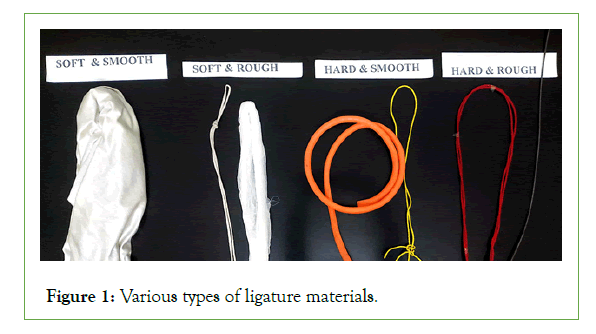
Figure 1: Various types of ligature materials.
Hard and smooth ligature material
Ligature materials with hard material make and having smooth surface texture are included in this group. The various examples are electric insulation wires, leather belts, rubber pipes and rubber tubes.
Hard and rough ligature material
Ligature materials with hard material make and having rough surface texture are included in this group. The various examples are nylon rope, jute rope, metallic chain, coir, and coconut rope.
Soft and smooth ligature material
Ligature materials with soft material make and having smooth surface texture are included in this group. The various examples are silk saree, silk dupatta, silk bedsheet and silk shawl.
Soft and rough ligature material
Ligature materials with soft material make and having rough surface texture are included in this group. The various examples are cotton saree, cotton dupatta, cotton bedsheet, cotton shawl, and cotton towel.
External and internal findings of neck were studied in relation to the ligature material and also upon the type of ligature material.
Results
Observed various ligature materials
The most commonly used ligature material was nylon rope (H&R) (52.6%) followed by Cotton Dupatta (S&R) (17.9%), Cotton Bedsheet (S&R) (8.4%), Cotton Saree (S&R) (7.4%), Silk Shawl (S&S) (3.2%), Silk Dupatta (S&S) (3.2%) and Electric Insulation wire (H&S) (02.1%) (Table 1).
| Ligature Material | Cases(n = 95) | |
|---|---|---|
| Hard and Rough | Nylon Rope (H&R) | 50 (52.6%) |
| Jute Rope (H&R) | 01 (1%) | |
| Coconut Rope (H&R) | 01 (1%) | |
| Metallic chain (H&R) | 01 (1%) | |
| Hard and Smooth | Electric Insulation wire (H&S) | 02 (2.1%) |
| Soft and Rough | Cotton Dupatta (S&R) | 17 (17.9%) |
| Cotton Bedsheet (S&R) | 08 (8.4%) | |
| Cotton Saree (S&R) | 07 (7.4%) | |
| Cotton Towel (S&R) | 01 (1%) | |
| Soft and Smooth | Silk Shawl (S&S) | 03 (3.2%) |
| Silk Dupatta (S&S) | 03 (3.2%) | |
| Silk Saree (S&S) | 01 (1%) |
Table 1: Observed various ligature materials.
While Jute Rope (H&R), Coconut Rope (H&R), Metallic chain (H&R), Cotton Towel (S&R) and Silk Saree (S&S) were rarely used ligature material with (1%) each.
Type of ligature material
Hard and rough group (55.8%) of ligature material was the commonest group of ligature material followed by soft and rough group (34.7%), soft and smooth group (7.4%) and hard and smooth group (2.1%) respectively (Table 2).
| Type of ligature material | Cases (n=95) |
|---|---|
| Hard and rough (H&R) | 53 (55.8%) |
| Hard and smooth (H&S) | 02 (2.1%) |
| Soft and rough (S&R) | 33 (34.7%) |
| Soft and smooth (S&S) | 07 (7.4%) |
Table 2: Type of ligature material.
Various external details of ligature marks
A) Position (level of mark): In majority (91.6%) of the cases ligature mark was above the level of thyroid cartilage while ligature mark was at the level of thyroid cartilage in (08.4%) cases. No cases were found in which ligature mark was below the level of thyroid cartilage (Table 3).
| Details of ligature mark | No of cases[n=95] | |
|---|---|---|
| Position(Level of mark in relation to thyroid cartilage) | Above | 87 (91.6%) |
| At | 08 (08.4%) | |
| Below | 0 (0%) | |
| Encircling of Mark around the Neck | Complete | 24 (25.3%) |
| Incomplete | 71 (74.7%) | |
| Periligature injuries | Present | 22 (23.2%) |
| Absent | 73 (76.8%) | |
| Weaving Pattern (Patterned Abrasion) | Present | 25 (26.3%) |
| Absent | 70 (73.7%) | |
Table 3: Various external details of ligature marks.
B) Encircling of mark around the neck: Ligature mark was incomplete or discontinuous in (74.7%) cases. Ligature mark was completely encircling the neck in (25.3%) cases.
C) Periligature injuries: Periligature injuries were seen in (23.2%) cases.
D) Weaving pattern (patterned abrasion): Weaving Pattern was observed in (26.3%) cases.
Characteristic of ligature marks in relation with ligature material
A) Weaving pattern (patterned abrasion ): Weaving pattern of ligature mark was most commonly seen in hard and rough (22.1%) type of ligature material followed by soft and rough type of ligature material (3.2%). However weaving pattern were seen in only (1%) cases of hard and smooth type of ligature material (Table 4).
| Characteristic | Hard and smooth | Hard and rough | Soft and smooth | Soft and rough | Total |
|---|---|---|---|---|---|
| Weaving Pattern | 1 (1%) | 21 (22.1%) | 0 | 3 (3.2%) | 25 (26.3%) |
| Slipping knot and Running noose | 1 (1%) | 14 (14.7%) | 1 (1%) | 6 (6.3%) | 25 (26.3%) |
| Fixed knot and fixed noose | 0 | 38 (40%) | 6 (6.3%) | 26 (27.4%) | 70 (73.7%) |
| Multiple turns | 1 (1%) | 1 (1%) | 0 | 1 (1%) | 3 (3.2%) |
Table 4: Characteristic of ligature material (n-95).
In all cases of ligature material having slipping knot the noose was of running type while all cases of ligature material having fixed knot the noose was of fixed type.
B) Type of noose: On examination of noose majority of the cases (73.7%) had fixed noose, of which hard and rough type of ligature material was used in 40% cases followed by soft and rough type of ligature material (27.4% cases).
Similarly majority cases of running type of noose (Slipping knot) was found in hard and rough (14.7%) type of ligature material followed by soft and rough (6.3%) type of ligature material.
C) Multiplicity of the loop of used ligature material: Single loop was seen in majority of the cases while multiple loops were seen in only (3.2%) cases.
Relationship of loop with ligature marks in association with periligature injuries
A) Relationship of loop with ligature marks: Most of the ligature material having running noose (Slipping knot) produced completely encircling ligature mark while most of the ligature materials having fixed noose (Fixed knot) produced incomplete ligature mark. Similarly completely encircling ligature mark was seen in all the cases of ligature materials having multiple turns (Table 5).
| Encircling of Mark around the Neck | Periligature injuries | ||||
|---|---|---|---|---|---|
| Characteristic | Complete | Incomplete | Periligature abrasions | Periligature ecchymosis | Periligature Blisters |
| Slipping knot and Running noose | 20 (21.1%) | 2 (2.1%) | 1 (1%) | 1 (1%) | 4 (4.2%) |
| Fixed knot and fixed noose | 1 (1%) | 69 (72.6%) | 8 (8.4%) | 5 (5.3%) | 1 (1%) |
| Multiple turns | 3 (3.2%) | 0 | 0 | 1 (1%) | 1 (1%) |
| Total | 24 (25.3%) | 71 (74.7%) | 9 (9.5%) | 7 (7.4%) | 6 (6.3%) |
Table 5: Relationship of loop with ligature marks in association with Periligature injuries.
B) Relationship of loop in association with periligature injuries: His most common type of periligature injuries in ligature material having running type of noose (slipping knot) was periligature blisters (4.2%). However the most common type of periligature injuries in ligature material having fixed type of noose (fixed knot) was periligature abrasions (8.4%) and periligature bruises (5.3%).
In cases having multiple turns, periligature bruises and periligature blisters were seen in (1%) cases each.
Periligature injuries in relation with type of ligature material
Periligature injuries were most commonly seen in Hard and rough type of ligature material followed by soft and rough type. However periligature injuries were infrequently seen in hard and smooth and soft and smooth type of ligature material (Table 6).
| Type of ligature material | Periligature abrasions | Periligature ecchymosis | Periligature Blisters |
|---|---|---|---|
| Hard and smooth | 0 | 0 | 1(1%) |
| Hard and rough | 5 (5.3%) | 3 (3.2%) | 5 (5.3%) |
| Soft and smooth | 0 | 1 (1%) | 0 |
| Soft and rough | 4 (4.2%) | 3 (3.2%) | 0 |
| Total | 9 (9.5%) | 7 (7.4%) | 6 (6.3%) |
Table 6: Periligature injuries in relation with type of ligature material (n=95).
Periligature abrasions were most commonly seen in Hard and rough type (5.3%) followed by soft and rough type (4.2%) ligature material. Similarly periligature ecchymosis was also commonly seen in Hard and rough type and Soft and rough type of ligature material with (3.2%) cases in both. While periligature blisters was commonly seen in hard and rough type (5.3%) cases followed by hard and smooth type (1%) cases.
Gross internal findings of neck in relation with ligature material
In only 20% cases haemorrhages in neck muscle Group was seen. However fracture of thyroid cartilage and fracture of hyoid bone was seen in only 5.3% and 3.2% cases respectively. Fracture of cricoid cartilage and cervical vertebra was not found in any cases (Table 7).
| Type of ligature material | Gross Internal findings of Neck (n=95) | ||||
|---|---|---|---|---|---|
| Haemorrhages in Muscle Group | Fracture of Hyoid bone | Fracture of Cricoid cartilage | Fracture of thyroid cartilage | Fracture of cervical vertebra | |
| Hard and smooth | 2 (2.1%) | 1 (1%) | 0 | 1 (1%) | 0 |
| Hard and rough | 14 (14.7%) | 2 (2.1%) | 0 | 3 (3.2%) | 0 |
| Soft and smooth | 0 | 0 | 0 | 0 | 0 |
| Soft and rough | 3 (3.2%) | 0 | 0 | 1 (1%) | 0 |
| Total | 19 (20%) | 3 (3.2%) | 0 | 5 (5.3%) | 0 |
Table 7: Gross Internal findings of Neck in relation with ligature material.
Haemorrhages in Muscle Group was commonly seen in hard and rough type ligature material (14.7%) cases followed by soft and rough type (3.2%) cases and hard and smooth type (2.1%) cases.
Fracture of hyoid bone was seen in hard and rough type (2.1%) and hard and smooth (1%) type of ligature material. While fracture of thyroid cartilage was seen in hard and rough type (3.2%) followed by soft and rough type and hard and smooth type with (1%) cases in each.
Discussion
Ligature material is the most important factor in cases of hanging. The strength and durability of the ligature material is important so as to suspend the body and with-hold the suspending weight without getting broke. The texture of the surface of the ligature material is important as when it comes in contact with the neck after suspension, the force applied can lead to various forms of injuries like ligature marks (Patterned abrasion), periligature ecchymosis (or Periligature bruise), periligature abrasions and periligature blisters.
Observed various ligature materials
Nylon rope (H&R) was also the most commonly used ligature material. Other commonly used ligature materials were cotton dupatta (S&R), cotton bedsheet (S&R), cotton saree (S&R) (Table 1).
Silk shawl (S&S), silk dupatta (S&S), electric insulation wire (H&S), jute rope (H&R), coconut rope (H&R), metallic chain (H&R), cotton towel (S&R) and silk saree (S&S) are rarely used ligature material.
Nylon rope (H&R) was also the most commonly used ligature material in Gupta [1] (rope 40.59% cases), Luke et al. [2] (rope 52% cases), Davison and Marshall [3] (rope 51% cases), Cooke et al. [4] (rope 59% cases), Pradhan et al. [5] (rope 47.72% cases), Bhosle et al. [6] (nylon rope 53.01% cases) and Ambade et al. [7] (nylon rope 63% cases).
Ahmad and Hossain [8] found Orna/dopatta 35.17% as the commonest ligature material. Patel et al. [9] found dupatta 67.5% as the commonest ligature material. Meera and Singh [10] found Cloth 57.14% as the commonest ligature material. Shaw [11] found Bed clothes 56% as the commonest ligature material.
Simonsen [12] found Packing twine or electric cord 58% as the commonest ligature material. Leigh10 et al. found Shoe/boot laces 32% as the commonest ligature material.
In the present study hard and rough group and soft and rough group were the commonly used ligature material type. This is in accordance with most of the reviewed literature as discussed above with nylon rope and dupatta being commonly used type of ligature material.
In the current study nylon rope (H&R) was the most commonly used ligature material accounting for about half (52.6%) of the total cases. Nylon rope is one of the common domestically used materials. Its easy availability coupled with hard material makes a sense of assurance to the suicidee that it can withhold the weight of the body. Hence nylon rope is the most commonly used ligature material in hanging.
Other commonly used ligature materials were cotton dupatta (S&R), cotton bedsheet (S&R) and cotton saree (S&R). Cotton is the most commonly used material for garments and household linens. Hence cotton made ligature materials are the second most commonly used ligature material. Silk material, electric insulation wire, jute rope, coconut rope and metallic chain were found to be less frequently used as ligature material.
Position (level of mark)
In the present study ligature mark was above the level of thyroid cartilage in majority (91.6%) of the cases. Similar findings were reported by Sharma et al. [13] with 84.62% cases having mark above the level of thyroid cartilage, 5.50% cases reported to have mark at thyroid level and 2.20% cases having mark below it. Jayaprakash and Sreekumari [14] noted that, ligature mark was at or above the level of thyroid cartilage in 96.3% of cases. Lower incidence was reported by Elfawal and Awad [15], accounting for 65.57% of cases with mark above the thyroid level and Dixit et al. [16], with 77% cases with mark above the thyroid level. Elfawal and Awad [15] and Dixit et al. [16] have not reported differentiated level of mark at the level of thyroid cartilage or below it but they clubbed both as below the level. They reported the level of mark below the level of thyroid cartilage in 34.59% and 23% cases respectively (Table 3).
In hanging there is a pull of the ligature material from the point of suspension resulting in shifting of the loop over the available space over neck, resulting in formation of ligature mark over the upper half of the neck.
Encircling of mark around the neck
In the present study ligature mark was incomplete or discontinuous in (74.7%) cases while ligature mark was completely encircling the neck in (25.3%) cases (Table 3).
Presence of hairs, intervening clothes as well as point of suspension pull of loop leads to the discontinuation or incompletion of the ligature mark around the neck.
There may also be some gap near the site of the knot due to the pull on the knot from the point of suspension above [17].
Weaving pattern (patterned abrasion)
Weaving Pattern abraded ligature mark is a particular type of ligature mark having weaving on it. This weaving pattern shows the type of ligature material used for hanging. Weaving Pattern was observed in (26.3%) cases. Weaving Pattern was most common in hard and rough ligature materials (22.1%) of total cases. The findings were similar to that of Luke et al. [2], Sharma [13] and Saisudhir and Nagaraja [18]. Sometimes the groove retains the pattern of the ligature material, e.g., a spiral weave of the rope (Tables 3 and 4) [19].
The grooving of ligature mark is more pronounced when the ligature material is narrower and harder and the suspension time is longer [20].
Type of noose
Fixed noose (Fixed knot) is seen in three fourth of the cases (73.7%) while the rest (26.3%) cases had running noose (Slipping knot). Sharma et al. [13] found fixed knot in 58.78% cases while 42.22% cases had Slip knot (Table 4), (Figures 2 and 3).
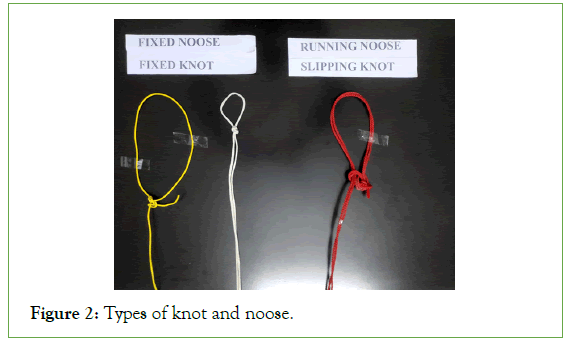
Figure 2: Types of knot and noose.
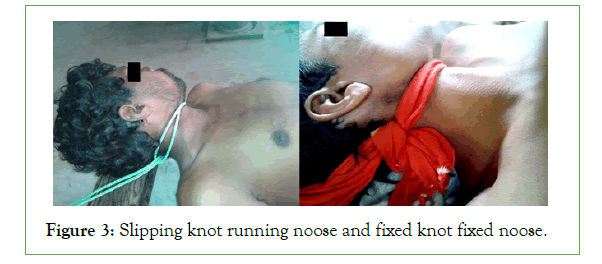
Figure 3: Slipping knot running noose and fixed knot fixed noose.
Fixed knot is common type of knot used irrespective of the type of ligature material used. It is very easy making loop having fixed noose and fixed knot, however to make slipping knot and running noose the person has to be well versed to the type of the knot. This could be the probable reason for the more prevalence of fixed noose and fixed knot.
When the ligature material used is hard and rough, fixed noose was seen in 40% cases while running noose was seen in 14.7% of total cases. Similarly when the ligature material used is soft and rough, fixed noose was seen in 27.4% cases while running noose was seen in 6.3% of total cases. Also when the ligature material used is soft and smooth, fixed noose was seen in 6.3% cases while running noose was seen in 1% of total cases.
Multiple loops were seen in (3.2%) cases. Sharma et al. [13] found multiple loops in 6.59% cases (Figure 4).
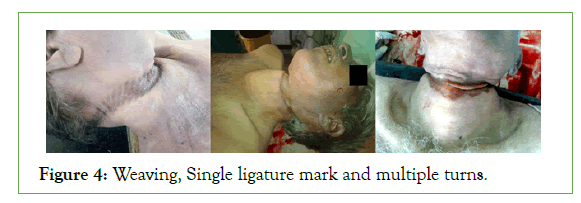
Figure 4: Weaving, Single ligature mark and multiple turns.
In the current study of the total 3 cases of multiple turns a single cases were of hard and rough, soft and rough and hard and smooth type ligature material.
A person with strong desire to end his life makes all possible attempts so that he definitely dies once he commits suicide, such persons can make multiple turns while hanging self.
Relationship of loop with ligature marks
Most of the ligature material having running noose produced completely encircling ligature mark. In cases of running noose the loop completely encircles the neck causing complete encircling of ligature marks. However when some intervening materials like victims clothes or victims own scalp hairs are between the ligature material and neck, it causes discontinuous ligature marks (Table 5).
Most cases of ligature materials having fixed noose produced incomplete ligature mark. In cases of fixed noose the ligature material loops are mostly larger in length as compared to the circumference of the neck. This causes a deficient space of ligature mark over neck. This is usually the site of lower point of suspension.
Periligature injuries in relation with type of ligature material
Various injuries are noted adjacent to ligature mark; these injuries are called as periligature injuries. Periligature ecchymosis (or Periligature bruise), periligature abrasions and periligature blisters Figur are the various periligature injuries (Tables 5 and 6) (Figur e 5).
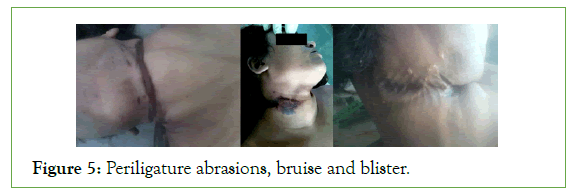
Figure 5: Periligature abrasions, bruise and blister.
Periligature injuries were seen in (23.2%) cases while periligature injuries were absent in (76.8%) cases. This is in accordance with the findings of Tumram et al. [21] who found periligature injuries in 14 (17.5%) cases out of total 80 cases studied. The ligature material producing periligature injuries were rough ones like nylon rope, and cotton rope as also reported in the findings of Tumram et al. [21].
The most common type of periligature injuries in ligature material having fixed type of noose was periligature abrasions (8.4%) and periligature bruises (5.3%). In fixed type of noose there is easy movement of the ligature loop over the neck surface resulting in production of superficial injuries over neck surface in the form of abrasions and bruises (ecchymosis).
While the most common type of periligature injuries in ligature material having running type of noose (slipping knot) was periligature blisters (4.2%). In running type of noose there is fixed entrapment of the ligature loop over the available neck surface. This results in least movement but firm entrapment of ligature loop generating more pressure leading to production of blisters.
The prevalence of periligature injuries are found to be most in hard and rough ligature material followed by soft and rough ligature material. Periligature injuries are found to be less prevalent in hard and smooth and soft and smooth ligature material. The surface texture of ligature material is more important than the material make for the causation of periligature injuries. The rough surface produces more friction between the ligature material and the neck tissues as compared to smooth surface. The more the amount of frictional force produced the more are the chances of production of periligature injuries. Periligature abrasions, periligature ecchymosis and periligature blisters are commonly seen present in hard and rough ligature material and soft and rough ligature material. Thus individually also each periligature injuries i.e., periligature abrasions, periligature ecchymosis and periligature blisters are commonly seen in rough surface type of ligature material. Periligature blisters was seen in only hard type ligature material while periligature abrasions and periligature ecchymosis were seen in both hard as well as soft type of ligature material.
Periligature injuries are produced by tough ligature material. Constriction of the neck by the noose sometimes causes pinching of the skin. This leads to the rubbing of the vertical folds against the noose producing periligature abrasions [22]. The friction of rope against skin produces considerable heat creating blisters by expressing tissue fluid into the upper layers of skin [21,23]. Vesiculations are usually found at the margin of ligature mark due to frictional force between ligature material and skin [24]. Bruise and nail marks on the neck may probably due to wedging of fingers under the noose in an attempt to remove the constriction [22]. Periligature abrasions with hemorrhagic areas are strongly suggestive of hanging caused during life while ecchymosis/bruises alone have no significance [25].
Gross internal findings of neck in relation with ligature material
In the present study, Haemorrhages in neck muscles were present in 20% cases. Similar soft tissue haemorrhages were also found by various studies [14,16,19]. However higher percentage of soft tissue haemorrhages were found by Hejna and Zátopková [26] and Sivasuthan et al. [27]. This may be due to higher cases of complete hanging with long drops (Table 7 and Figure 6).
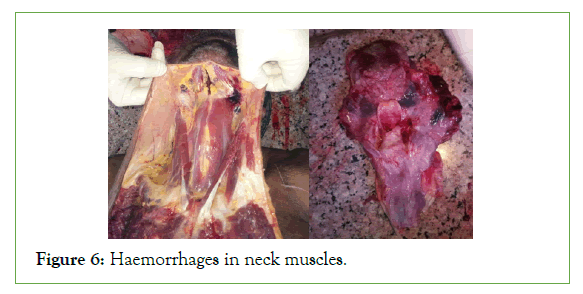
Figure 6: Haemorrhages in neck muscles.
Haemorrhages in sternocleidomastoideus muscle of the neck, are produced by lesions of capillaries, small veins and small arteries and also by damage of muscle fibres. Indirect impact stretches muscle fibres and blood vessels very much, far away from the locality of direct impact. Normally blood vessel and its small branches are adapted to contraction and stretching due to the thick connective tissue surrounding the vessels. During hanging there is maximal stretching of neck tissues and disruption of surrounding connective tissue. Thus blood vessels may be torn, especially vessels that branch off nearly at a right angle. Blood then flows into the small areas of connective tissue surrounding the vessels [28].
In the present study fracture of hyoid bone was present in 3.2% cases of hanging. Similar findings were also found in different studies [14,29-31]. However higher incidence of hyoid fracture were reported by Morild [32] (16%), Dixit et al. [16] (14%), Sharma et al. [33] (21%) and Ahmad and Hossain [8] (27%). Naik and patil [34] in their study of 257 cases of hanging did not found a single victim having fracture of hyoid bone suggesting incidence of hyoid bone in hanging as rare. In our study more than 70% cases were from younger age group in which hyoid bone is yet to get completely ossified. So this might be one of the reasons for less number of hyoid bone fractures. Non-meticulous examination during autopsy, assigning joint mobility between body and greater cornu of hyoid as fracture were supposed as causes of increased incidence of hyoid fracture in other studies [34].
Younger individuals are slighter in built having longer bone with smaller angle. So a greater force is required to fracture the hyoid bone by means of ligature and hence incidence of fracture of hyoid bone increases with age in such cases [35].
In the present study, fracture of thyroid cartilage was present in 5.3% cases. Similar findings were also found in different studies [14,36]. However higher incidence of fracture of thyroid cartilage were reported by Morild [32] in 12.5% cases, Dixit et al. [16] in 15%, Azmak [37] in 30% cases, Demirci et al. [38] in 35% cases, Ahmad and Hossain [8] in 19% cases, Clement et al. [30] in 27% cases and Godin et al. [31] in 20.8% cases respectively.
Nikolic et al. [39] found fracture of throat skeleton in (68%) cases of hanging. Balabantaray [40] found fracture of the hyoid bone or thyroid cartilage in 26% cases of hanging. On the contrary Bowen [41] and Guarner and Hanzlick [42] found no fractures of thyrolaryngeal cartilage in cases of hanging.
Haemorrhages in Muscle Group was commonly seen in hard and rough type ligature material (14.7%) cases followed by soft and rough type (3.2%) cases and hard and smooth type (2.1%) cases. Fracture of hyoid bone was seen in hard and rough type (2.1%) and hard and smooth (1%) type of ligature material. While fracture of thyroid cartilage was seen in hard and rough type (3.2%) followed by soft and rough type and hard and smooth type with (1%) cases in each.
Thus internal injuries to neck in hanging are more common in hard and rough ligature material, followed by soft and rough and hard and smooth ligature material. Internal injuries to neck are found to be least prevalent in soft and smooth ligature material.
Hard material make ligature materials are comparatively heavier and thus impart more mass over the neck around the ligature mark. On suspension of body heavy material make ligature materials thus impart more force over the neck around the ligature mark.
Rough surface ligature materials on the other hand impart more frictional forces as compared to smooth surface ligature materials. These frictional forces coupled with applied forces around neck results in stronger forces.
Thus there is increased prevalence of external and internal injuries in hard make ligature materials and rough surface ligature materials.
Conclusion
In cases of hanging meticulous forensic examination of the neck is of great importance to ascertain the mechanism of death, antemortem character of the lesion and to determine the manner of death. Our study systematically analyzed the various external and internal injuries in cases of hanging. Study of these injuries in relation to the type of ligature material used is very important for the occurrence of injuries over the neck in cases of hanging. The material make and the surface texture of the ligature material are very important factors for the causation of various external and internal injuries over neck in cases of hanging. Studies of the ligature material make and the surface texture thus helps in cases of hanging. Detailed analysis of ligature materials and their types can help in correlating the various anatomical and pathological findings associated in fatalities due to hanging.
Declaration
Conflict of interest
None
Source of Funding
No funding received.
Acknowledgement
None
REFERENCES
- Sen Gupta BK. Studies on 101 cases of death due to hanging. J Indian Med Assoc. 1965; 45(3):135-140.
[GoogleScholar], [Pubmed]
- Luke JL, Reay DT, Eisele JW, Bonnell HJ. Correlations of circumstances with pathological findings in asphyxia deaths by hanging: a prospective study of 61 cases from Seattle, WA. J Forensic Sci. 1985; 30(4):1140-1147.
[GoogleScholar], [Pubmed]
- Davison A, Marshall TK. Hanging in northern Ireland-a survey. Med Sci Law.1986; 26(1):23-28.
- Cooke CT, Cadden GA, Margolius KA. Death by hanging in Western Australia. Pathology. 1995; 27(3):268-272.
[Crossref], [GoogleScholar], [Pubmed]
- Pradhan A, Mandal BK, Tripathi CB. Hanging:nature of ligature material applied and type of hanging according to point of suspension. Nepal Med Coll J. 2012; 14(2):103-106.
[GoogleScholar], [Pubmed]
- Bhosle SH, Batra AK, Kuchewaar SV. Violent asphyxia death due to hanging: a prospective study. J Forensic Med Sci Law. 2014; 23(1):1-8.
- Ambade VN, Tumran N, Meshram S, Borkar J. Ligature material in hanging deaths: The neglected area in forensic examination. Egypt J Forensic Sci. 2015; 5(3):109-113.
- Ahmad M, Hossain MZ. Hanging as a method of suicide: Retrospective analysis of postmortem cases. JAFMC Bangladesh. 2010; 6(2):37-39.
- Patel AP, Bansal A, Shah JV, Shah KA. Study of hanging cases in Ahmedabad region. J Ind Acad Forensic Med. 2012; 34(4):342-345.
- Meera T, Singh MBK. Pattern of neck findings in suicidal hanging- a study in Manipur. J Ind Acad Forensic Med. 2011; 33 (4):352-354.
- Shaw D, Fernandes JR, Rao C. Suicide in children and adolescents: A 10- year retrospective review. Am J Forensic Med Pathol. 2005; 26(4):309-315.
[Crossref], [GoogleScholar], [Pubmed]
- Simonsen J. Patho-anatomic findings in neck structures in asphyxiation due to hanging: a survey of 80 cases. Forensic Sci Int. 1988; 38 (1-2):83-91.
[Crossref], [GoogleScholar], [Pubmed]
- Sharma BR, Harish D, Singh VP, Sigh J. Ligature Mark on the neck: how Informative? J Indian Acad Forensic Med. 2005; 27(1):10-15.
- Jayaprakash S, Sreekumari K. Pattern of injuries to neck structures in hanging-an autopsy study. Am J Forensic Med Pathol. 2012; 33(4):395-399.
[Crossref], [GoogleScholar], [Pubmed]
- Elfawal MA, Awad OA. Deaths from Hanging in the Eastern province of Saudi Arabia. Med Sci Law. 1994; 34(4):307-312.
[Crossref], [GoogleScholar], [Pubmed]
- Dixit PG, Mohite PM, Ambade VN. Study of histopathological changes in thyroid, salivary gland and lymph nodes in hanging. J Forensic Med Toxicol. 2001; 18(2):1-4.
- Nandy A. Principles of forensic medicine including toxicology. 3rd ed. Kolkata: New Central Book Agency Pvt. Ltd; 2010; 517-564.
- Saisudhir T, Nagaraja TV. A study of ligature mark in cases of hanging deaths. Int J Pharm Biomed Sci. 2012; 3(3):80-84.
- Buris L. Forensic medicine. Budapest: Springer; 1993. 225.
- Tumram NK, Ambade VN, Bardale RV, Dixit PG. Injuries over neck in hanging deaths and its relation with ligature material: Is it vital? J Forensic Leg. 2014; 22:80-83.
[Crossref], [GoogleScholar], [Pubmed]
- Tumram NK, Bardale RV, Dixit PG. Periligature Injuries in Hanging- A Taciturn Proof. Indian Internet J Forensic Med Toxicol. 2010; 8(4):141-147.
[Crossref], [GoogleScholar], [Pubmed]
- Spitz WU. Spitz and Fisher’s medicolegal investigation of death. guidelines for the application of pathology to crime investigation, 3rd edition, Charles C Thomas publisher. 1993; 453.
- Mohanty MC, Rastogi P, G Pradeepkumar, Virendrakumar, Shahnawaz M. Periligature injuries in hanging. J Clin Forensic Med. 2003; 10(4):255-227.
[Crossref], [GoogleScholar], [Pubmed]
- Wankhede A G. Jaypee Gold Standard Mini Atlas Series Forensic Medicine, Jaypee brothers medical publishers (p) Ltd, 1st edition. 2008;176-184.
- Mathiharan K, Patnaik A K. Modi’s medical jurisprudence and toxicology, 23rd edition, LexisNexis Butterworths, 2006; 569.
- Hejna P, Zátopková L. Significance of hemorrhages at the origin of the sternocleidomastoid muscles in hanging. Am J Forensic Med Pathol. 2012; 33(2):124-127.
[Crossref], [GoogleScholar], [Pubmed]
- Sivasuthan S, Girish S, Babu PK, Padma K, John L, Unmesh AK, et al. Sternomastoid rupture an index of antemortem hanging- an autopsy study of hundred cases. IIJFMT. 2005; 3(4).
- Adebahr G, Erkrath KD. Haemorrhages, directly and indirectly in origin, localised in the musculus sternocleidomastoideus. (Contribution towards the angio-architecture of the skeletal muscle) (author's transl).[Article in German] Z Rechtsmed. J Leg Med. 1981; 87(1-2):41-49.
[Crossref], [GoogleScholar], [Pubmed]
- Sheikh MI, Agarwal SS. Medicolegal implications of hyoid bone fracture-A study. J Indian Acad Forensic Med.2001; 23(4):61-63.
- Clement R, Guay JP, Sauvangeau A. Fracture of neck structures in suicidal hangings: a retrospective study on contributing variables. Forensic Sci Int. 2011; 207(1-3):122-126.
[Crossref], [GoogleScholar], [Pubmed]
- Godin A, Kremer C, Sauvageau A. Fracture of the cricoid as a potential pointer to homicide A 6-year retrospective study of neck structures fractures in hanging victims. Am J Forensic Med Pathol 2012; 33(1):4-7.
[Crossref], [GoogleScholar], [Pubmed]
- Morild I. Fractures of neck structures in suicidal hanging. Med Sci Law. 1996; 36(1):80-84.
[Crossref], [GoogleScholar], [Pubmed]
- Sharma BR, Harish D, Sharma A, Sharma S, Singh H. Injuries to neck structures in deaths due to constriction of neck, with a special reference to hanging. J Forensic Leg Med. 2008; 15(5):298-305.
[Crossref], [GoogleScholar], [Pubmed]
- Naik S, Patil DY. Fracture of hyoid bone in cases of asphyxial deaths resulting from constructing force around the neck. J Indian Acad Forensic Med. 2005; 27(3):149-153.
- Lebreton-Chakour C, Godio-Raboutet Y, Torrents R, Chaumoitre K, Boval C, Bartoli C. et al. Manual strangulation: experimental approach to the genesis of hyoid bone fractures. Forensic Sci Int. 2013; 228(1-3):47-51.
[Crossref], [GoogleScholar], [Pubmed]
- Feigin G. Frequency of neck organ fractures in hanging. Am J Forensic Med Pathol. 1999; 20(2):128-130.
[Crossref], [GoogleScholar], [Pubmed]
- Azmak D. Asphyxial deaths: a retrospective study and review of literature. Am J Forensic Med Pathol. 2006; 27(2):134-144.
[Crossref], [GoogleScholar], [Pubmed]
- Demirci S, Dogan KH, Erkol Z, Gunaydin G. Ligature strangulation deaths in the province of Konya (Turkey). J Forensic Leg Med. 2009; 16(5):248-252.
[Crossref], [GoogleScholar], [Pubmed]
- Nikolic S, Micic J, Atanasijevic T, Djokic V, Djonic D. Analysis of neck injuries in hanging. Am J Forensic Med Pathol. 2003; 24:179-182.
[Crossref], [GoogleScholar], [Pubmed]
- Balabantaray JK. Findings in Neck Structures in Asphyxiation due to Hanging. J Indian Acad Forensic Med. 1998; 20(4): 82-84.
- Bowen B.A. Hanging – A review. Forensic Sci Int. 1982; 20(3):247-249.
[Crossref], [GoogleScholar], [Pubmed]
- Guarner J, Hanzlick R. Suicide by hanging. A review of 56 cases. Am J Forensic Med Pathol. 1987; 8(1):23-25.
[Crossref], [GoogleScholar], [Pubmed]
Citation: Karmakar SN, Tumram NK, Dixit PG (2022) Descriptive Analysis of Ligature Composition in Correlation with Patho-Anatomic Findings in Neck Region Due to Hanging Fatalities. J Forensic Biomech. 13:390.
Copyright: © 2022 Karmakar SN, et al. This is an open access article distributed under the terms of the Creative Commons Attribution License, which permits unrestricted use, distribution, and reproduction in any medium, provided the original author and source are credited.
